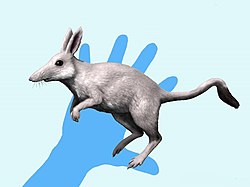Description
Skull of Asiatherium is 30 mm (1.2 in) in length. [1] This animal was roughly the size of a mouse, and is known from a fairly complete articulated skeleton, preserving a complete skull. Its teeth resembled roughly those of marsupials; it possessed three premolars and four molars, and the mandible was slightly curved. Compared to Deltatheridium , Asiatherium was even more marsupial-like, due to its molars having paraconids lower than the metaconids, and the paired entoconid-hypoconulid cusps on the lower molars. The stylar platform of the upper molars was however narrower and the stylar cusps weaker than in primitive marsupials. The upper molars differed from those of marsupials in their expanded praecingula and postcingula. [2]
Classification
Asiatherium reshetovi was first described in 1994, based on fossils found in the Udan-Sayr locality of the Djadokhta Formation, in Mongolia. Asiatherium seems to be related to early marsupials, but probably was nested within a different clade of Metatherian, Deltatheroida, nested alongside Deltatheridium. The skeleton of Asiatherium looked like that of a basal Therian; epipubic bones, typical of marsupials, were present.
This page is based on this
Wikipedia article Text is available under the
CC BY-SA 4.0 license; additional terms may apply.
Images, videos and audio are available under their respective licenses.





